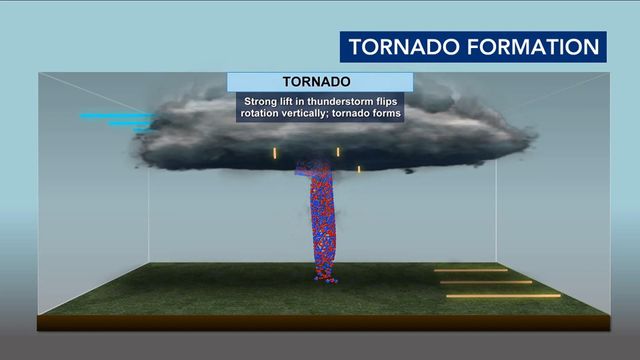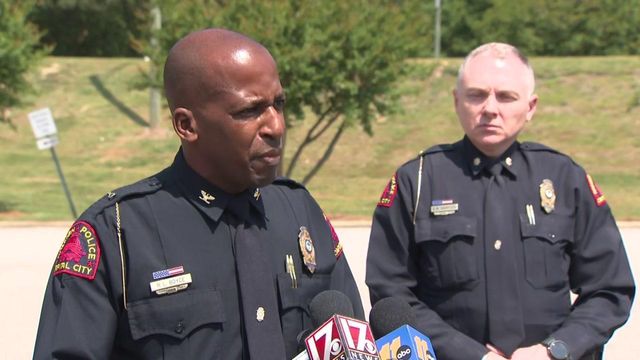Worst NC tornadoes: In-depth look at NC tornado history
Tornadoes can happen anywhere in North Carolina. Keep reading to discover some of the worst NC tornadoes and a lesson on NC tornado history.
The National Oceanic and Atmospheric Administration has tracked tornadoes since 1950. North Carolina has not seen an EF5 tornado — a tornado with winds of more than 200 mph — since tracking began.
However, North Carolina has seen several EF4 tornadoes in its history.
When was the last tornado in North Carolina?
On Dec. 10, a tornado damaged more than 20 homes in Garner, in Wake County. The tornado traveled about 1.5 miles. It was on the ground for about four minutes bust after 12:30 p.m. and carried top wind speeds of 110 mph.
Trees fell onto homes and cars, and piles of debris were visible along Timber Drive. No one was injured, according to the town.
On July 19, an EF3 tornado devastated Edgecombe and Nash counties.
There were 16 confirmed injuries – 13 in Nash County and three in Edgecombe County.
The EF3 tornado caused the area's largest employer, Pfizer, to shut down its plant in Rocky Mount until further notice. Pfizer employed more than 3,200 workers at its Rocky Mount plant.
NC tornado history
As of Feb. 28, 2023, NOAA data shows North Carolina has had 1,593 tornadoes, 2,639 direct injuries, 124 indirect injuries, 132 direct fatalities, three indirect fatalities, about $1.74 billion worth of damage and $4.81 million of crop damage.
Before looking at the history of tornadoes in central North Carolina specifically, here is how they’re measured.
NC tornadoes: What is an EF scale?
The Enhanced Fujita Scale (EF scale) rates tornado intensity based on the severity of the damage they cause.
- EFU: Unknown: No surveyable damage
- EF0: 65-85 mph: Light damage
- EF1: 86-110 mph: Moderate damage
- EF2: 111-135 mph: Considerable damage
- EF3: 136-165 mph: Severe damage
- EF4: 166 -200 mph: Devastating damage
- EF5: More than 200 mph: Incredible damage
In February 2007, the EF-Scale replaced the Fujita scale in the U.S. The change was to reflect better examinations of tornado damage surveys to align wind speeds more closely with associated storm damage.
Fujita scale
- F0: Less than 73 mph: Light damage
- F1: 73-112 mph: Moderate damage
- F2: 113-157 mph: Considerable damage
- F3: 158-206 mph: Severe damage
- F4: 207-260 mph: Devastating damage
- F5: 261-318 mph: Incredible damage
Here’s a look at the history of tornadoes in central North Carolina. The outbreaks in April 2011 and March 1984 are considered the worst in state history.
Worst NC tornadoes: Triangle outbreak of April 2011
On April 16, 2011, 30 tornadoes touched down in North Carolina for the greatest one-day total on record in the state.
A total of 24 people died that day in North Carolina, including eight people in central North Carolina. Hundreds more were injured.
Nine tornadoes occurred in the National Weather Service (NWS) Raleigh (RAH) County Warning Area (CWA). The areas impacted include the city of Raleigh along with Clinton, Cottonade, Holly Springs and Fayetteville. Among the nine, there were two EF-3 tornadoes, four EF-2 tornadoes and three EF-1 tornadoes.
At the Stony Brook North Mobile Home Park in Raleigh, 27 homes were destroyed and four children died.
Tornadoes hit the Deep South on Friday, April 15, 2011, foreshadowing what was to come for North Carolina. WRAL meteorologist Elizabeth Gardner said meteorologists were tracking the storms for days, but no one was prepared for what happened.
"I can remember we were watching this several days before these tornadoes arrived," Gardner recalled. "We could see the development, we could see the atmosphere looking like it could support some strong thunderstorms and tornadoes. But the day of, the storm prediction center gave us the very highest level risk for severe storms, and that was something I had never seen in our area before."
WRAL weather executive producer Aimee Wilmoth talked to WRAL meteorologist Mike Maze and former WRAL meteorologist Nate Johnson, who were both working that day.
Johnson said it started as a nice spring morning, but things quickly changed.
"You could feel it," he said. "There are days you just feel the atmosphere loaded with energy, and you knew it was going to be a long day, you knew it was going to be a rough day. Our job in that moment is just to try to get people through it.”
On April 16, 2011, at 2:53 p.m., a tornado slammed down in Sanford. Then, moving northeast at 500 yards wide, the storm hit Holly Springs in southern Wake County.
The storm hit the Stonybrook mobile home park off Brentwood Road in Raleigh then continued traveling a total of more than 65 miles, finally dissipating on the far side of Roanoke Rapids just before 5:30 p.m.
That was one of the worst storms on April 16, 2011, carving a path of destruction through several Raleigh neighborhoods and claiming the lives of four young children.
Meanwhile, at 3:31 p.m., another storm was spotted in Hoke County. Within 15 minutes, the EF-3 tornado touched down, carving a path 800 yards wide.
At 4:33 p.m., a storm crossed the Bladen and Cumberland County line. The EF-2 tornado killed three people as it moved toward Clinton in Sampson County. Around 5 p.m., the storm weakened and the tornado dissipated.
The April 16 tornadoes ripped through parts of Fayetteville and Cumberland County, destroying 150 homes and damaging just as many. A tornado ripped the roof off Ben Martin Elementary School, but because it was Saturday, no children were inside.
November 2008 tornado outbreak
During the late-night and early-morning hours of Nov. 14, 2008, and Nov. 15, 2008, there were seven tornadoes.
The tornadoes killed two people and damaged homes as it moved north from Robeson County to Halifax County.
The worst-hit area appeared to be Kenly on the Johnston-Wilson county line.
The strongest tornado was an EF3.
April 15, 1996, tornadoes in Wake County
A tornado touched down in Zebulon, where 16 homes were destroyed. Miraculously, there were no deaths associated with the storm.
November 1988 Raleigh tornado outbreak
There were seven tornadoes reported in northeastern North Carolina and southeastern Virginia between 1 a.m. and 5:45 a.m. on Nov. 28, 1988.
The F-4 Raleigh tornado killed four people and injured more than 150 others.
The tornado remained on the ground for more than 80 miles, leaving destruction in several counties, including Wake, Franklin and Nash. The most intense damage occurred over northwestern Raleigh where the tornado traveled through densely populated areas near major intersections.
WRAL News anchor Charlie Gaddy went live that night from the Glenwood Avenue Kmart, which the twister had leveled.
"The Townridge Shopping Center is built in a V or an L (shape) and half of it is gone. That means that the Kmart has been demolished and several businesses adjacent to it,” Gaddy said during his first report from the scene.
March 28, 1984, Carolinas tornado outbreak
The Carolinas Outbreak of March 28, 1984, was one of the deadliest, most destructive tornado outbreaks in the history of the two Carolinas. It is referred to as the Red Springs Tornado.
The final count shows 24 individual tornadoes touched down: 11 in North Carolina, 11 in South Carolina, and 2 in Georgia. The human impact included 57 fatalities, (42 in North Carolina, 15 in South Carolina, none in Georgia) and 1,248 injuries (799 in North Carolina, 448 in South Carolina, and 1 in Georgia).
Tornadoes ripped through Cumberland, Lenoir, Nash, Pitt, Robeson, Sampson and Wayne counties. They ranged from F2, F3 and F4 on the Fujita Scale.
Download the WRAL Weather app, signup for WRAL WeatherCall
Tornadoes form quickly, and it's important to act fast if there is a tornado warning in your area. Download the free WRAL Weather app to get severe weather alerts even during a power outage.
Anyone can also sign up for WRAL WeatherCall, which works 24 hours a day. If it’s 3 a.m. and there’s a tornado warning in your neighborhood, the WeatherCall service will call your landline or mobile number and tell you what to do.
WeatherCall uses your street address to determine whether your home or business is inside a severe thunderstorm or tornado warning area.
The WeatherCall service is provided by Media Weather Innovations, LLC. If you need help or have questions about your subscription or the service, contact WeatherCall Customer Service by email, or info@weathercall.net or call 1-800-260-6695.
Tornado safety tips: How to stay safe during a tornado
Seek shelter in a substantial building.
In a home or building, move to a pre-designated shelter, such as a basement, bathroom or closet.
If an underground shelter is not available, move to an interior room or hallway on the lowest floor, and get under a sturdy piece of furniture.
Stay away from windows.
If you are caught outdoors, seek shelter in a low spot like a ditch or culvert. You want to get as low as possible to protect yourself from all of the flying debris in a tornado. Protect your head with your hands.
If in you're in a vehicle and threatened by a tornado, abandon your vehicle and seek shelter in a substantial structure or in a ditch. Never try to outrun a tornado in a vehicle. Tornadoes do not travel in straight lines, and it can be very difficult to determine what direction the tornado is moving.

Tornado watch vs. tornado warning
A tornado watch means weather conditions are favorable for tornado formation. A warning means a tornado has been spotted or radar has indicated a tornado.
Take shelter in the lowest level of a home or building, away from windows, during a warning. During a tornado watch, make sure you are watching WRAL News or have access to alerts.


















